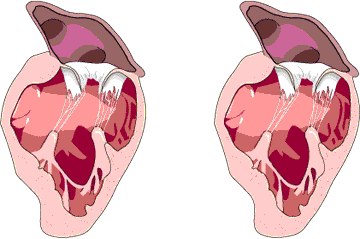M I T R A L V A L V E P R O L A P S E
HeartPoint animation: this will take approximately 15 seconds
to load.

The "mitral valve" is a structure in the heart which is between the upper chamber on the left side of the heart (the "left atrium") and the lower chamber on the left (the "left ventricle"). The mitral valve opens when the lower chamber is "resting", allowing blood to flow in, and then closes as the left ventricle contracts, preventing blood from going backwards.
Stretching of the connective tissue of which the valve is made of allows the valve to stretch or bow slightly into the left atrium (the medical term for this is "prolapse"). The doctor can often hear this with the stethoscope as a "click", and see it on the echocardiogram and perhaps other tests as well.
Mitral valve prolapse (MVP) is a common condition, occurring in up to 20% of the population. Is more common in females, in those who are tall with long arms and legs, and tends to run in families. In most cases, it is quite benign. I like to compare it to being "double-jointed", a case in which the joint itself is perfectly normal, but the supporting structures are lax, and allow the person to obtain unusual, but not dangerous, positions.
©COPY 1997 HeartPoint Updated July 1997
